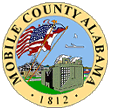

A HISTORY OF CHICKASABOGUE PARK
|
The first residents to occupy the area along the banks of Chickasabogue, within the boundaries of Chickasabogue Park, were Indians of the Woodland and Mississippi Periods about 1500 B.C. Archeological research has located their camp sites at several locations within the park. In 1711 French Governor Jean Baptiste Le Moyne, Sieur de Bienville, settled the Apalachee Indians on the banks of Chickasabogue. They remained in their village, called St. Louis de la Apalachee, until late 1732 when they moved to what was later to become Blakeley on the Tensaw River in Baldwin County, Alabama. The earliest European habitation in Chickasabogue Park cam when a Spanish Grandee, Don Diego Miguel Alvarez, received a grant on the north side of Chickasabogue from Don Vincent Folch on June 23, 1787. In his humble petition for his grant, Alvarez noted he had already lived on the site for five years. Bazille Chastang, a free mulatto, born in 1775, son of well-known local land owner Dr. John Chastang, received a grant within the Park from Joaquim Osorno on October 8, 1804. He built a home on Chickasabogue and cultivated and inhabited the property from 1804 to 1808. He died in September 1830. William D. Stone purchased 640 acres within the park from Chastang on November 29, 1828. Shortly afterwards he build a sawmill on Eight Mile Creek, near Gum Tree Branch. This mill closed prior to 1856. Frederic Daniel Myers was born in Orangeburg, S.C. on August 11, 1792. He died and was buried in the Myers Cemetery within the park on November 16, 1866. He and sons, David, Daniel P. and John, all natives of South Carolina, built a saw mill and village as early as 1843 on Chickasabogue. A public school operated in the village prior to its burning in 1856. On their plantation, the Myers' operated a saw mill, a grist mill, a brick kiln, and produced rice, corn, livestock and forest products. At the end of the Civil War, Chickasabogue Park was the site of refuge for the residents of Whistler as Union troops captured their village. Approximately 700 men, women and children fled to the Park and hid in the swamp. When Federal troops occupied the area, one of the first things they did was to put the Myers sawmill and grist mill back into operation. The Myers families continued to operate their sawmill until D.S. Myers sold the property on October 2, 1903. Over the years numerous camps were built within the Park and as early as the depression years a private recreational facility operated at the beach. Chickasabogue Park was designed and constructed to provide Mobile County citizens with a centrally located facility offering a wide variety of activities in a natural setting. The original 750 acres the Park covered were donated to Mobile County by Scott Paper Company in 1969. An additional 300 acres were added to the Park at a later date. |
|
|
HOME | NEWS | SITE MAP | OVERVIEW | MOBILE COUNTY COMMISSION | ORGANIZATION
COUNTY FACTS | COUNTY BIDS | FINANCES | RECREATION | CITIES | CALENDAR
DEPARTMENTS | COUNTY-CITY DAY | LINKS | CONTACT US
Copyright © 2023 mobilecounty.org. All Rights Reserved